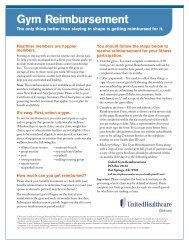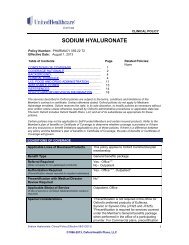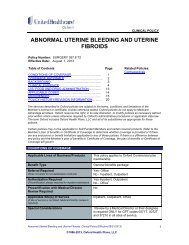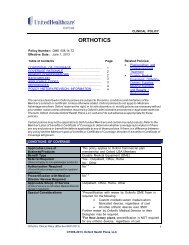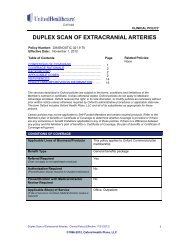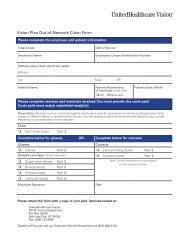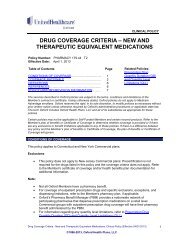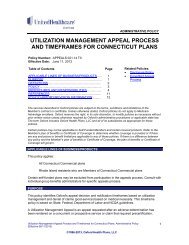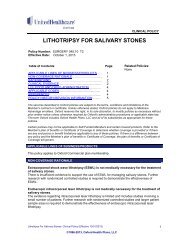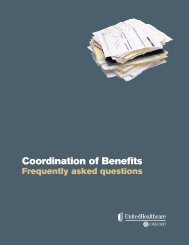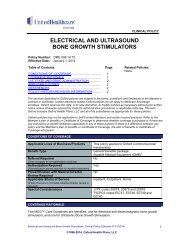observation care evaluation and management codes - Oxford Health ...
observation care evaluation and management codes - Oxford Health ...
observation care evaluation and management codes - Oxford Health ...
Create successful ePaper yourself
Turn your PDF publications into a flip-book with our unique Google optimized e-Paper software.
REIMBURSEMENT POLICYOBSERVATION CARE EVALUATION ANDMANAGEMENT CODESPolicy Number: ADMINISTRATIVE 232.6 T0Effective Date: April 1, 2013Table of ContentsAPPLICABLE LINES OF BUSINESS/PRODUCTS…..APPLICATION……………...........................................OVERVIEW..................................................................REIMBURSEMENT GUIDELINES...............................DEFINITIONS..............................................................QUESTIONS AND ANSWERS....................................RESOURCES/REFERENCES.....................................POLICY HISTORY/REVISION INFORMATION..........Policy History Revision InformationThe services described in <strong>Oxford</strong> policies are subject to the terms, conditions <strong>and</strong> limitations of theMember's contract or certificate. Unless otherwise stated, <strong>Oxford</strong> policies do not apply to Medi<strong>care</strong>Advantage enrollees. <strong>Oxford</strong> reserves the right, in its sole discretion, to modify policies as necessary withoutprior written notice unless otherwise required by <strong>Oxford</strong>'s administrative procedures or applicable state law.The term <strong>Oxford</strong> includes <strong>Oxford</strong> <strong>Health</strong> Plans, LLC <strong>and</strong> all of its subsidiaries as appropriate for thesepolicies.Certain policies may not be applicable to Self-Funded Members <strong>and</strong> certain insured products. Refer to theMember's plan of benefits or Certificate of Coverage to determine whether coverage is provided or if thereare any exclusions or benefit limitations applicable to any of these policies. If there is a difference betweenany policy <strong>and</strong> the Member’s plan of benefits or Certificate of Coverage, the plan of benefits or Certificate ofCoverage will govern.APPLICABLE LINES OF BUSINESS/PRODUCTSThis policy applies to <strong>Oxford</strong> Commercial plan membership.APPLICATIONThis policy applies to all products, all network <strong>and</strong> non-network physicians <strong>and</strong> other health <strong>care</strong>professionals. This includes non-network authorized <strong>and</strong> percent of charge contract physicians<strong>and</strong> other health <strong>care</strong> professionals.OVERVIEWPageRelated Policies:Global DaysInitial <strong>observation</strong> <strong>care</strong> CPT ® <strong>codes</strong> 99217-99220 <strong>and</strong> subsequent <strong>observation</strong> <strong>care</strong> CPT <strong>codes</strong>99224-99226 are used to report <strong>evaluation</strong> <strong>and</strong> <strong>management</strong> (E/M) services provided to new orestablished patients designated as "<strong>observation</strong> status" in a hospital.Observation service (including admission <strong>and</strong> discharge) CPT <strong>codes</strong> 99234-99236 are used toreport E/M services provided to patients admitted <strong>and</strong> discharged on the same date of service.11125566Observation Care <strong>and</strong> Evaluation <strong>and</strong> Management Codes: Reimbursement Policy (Effective 04/01/2013)©1996-2013, <strong>Oxford</strong> <strong>Health</strong> Plans, LLC1
For the purpose of this policy, the same specialty physician is defined as a physician <strong>and</strong>/orhealth <strong>care</strong> professional of the same group <strong>and</strong> same specialty reporting the same Federal TaxIdentification number.REIMBURSEMENT GUIDELINESInitial Observation CareThe physician supervising the <strong>care</strong> of the patient designated as "<strong>observation</strong> status" is the onlyphysician who can report an <strong>observation</strong> <strong>care</strong> CPT code (99218-99220). It is not necessary thatthe patient be located in an <strong>observation</strong> area designated by the hospital, although in order toreport the <strong>observation</strong> <strong>care</strong> <strong>codes</strong> the physician must:Indicate in the patient's medical record that the patient is designated or admitted as<strong>observation</strong> status;Clearly document the reason for the patient to be admitted to <strong>observation</strong> status; <strong>and</strong>Initiate the <strong>observation</strong>s status, assess, establish <strong>and</strong> supervise the <strong>care</strong> plan for<strong>observation</strong> <strong>and</strong> perform periodic reassessments.The CPT codebook states that "when "<strong>observation</strong> status" is initiated in the course of anencounter in another site of service (eg, hospital emergency department, physician's office,nursing facility) all <strong>evaluation</strong> <strong>and</strong> <strong>management</strong> services provided by the supervising physician inconjunction with initiating "<strong>observation</strong> status" are considered part of the initial <strong>observation</strong> <strong>care</strong>when performed on the same date. The <strong>observation</strong> <strong>care</strong> level of service reported by thesupervising physician should include the services related to initiating "<strong>observation</strong> status"provided in the other sites of services as well as in the <strong>observation</strong> setting."<strong>Oxford</strong> follows the Centers for Medi<strong>care</strong> <strong>and</strong> Medicaid Services' (CMS) Claims ProcessingManual which provides the instructions, "for a physician to bill the initial <strong>observation</strong> <strong>care</strong> <strong>codes</strong>[99218-99220], there must be a medical <strong>observation</strong> record for the patient which contains dated<strong>and</strong> timed physician's admitting orders regarding the <strong>care</strong> the patient is to receive while in<strong>observation</strong>, nursing notes, <strong>and</strong> progress notes prepared by the physician while the patient was in<strong>observation</strong> status. This record must be in addition to any record prepared as a result of anemergency department or outpatient clinic encounter."Consistent with CMS guidelines, <strong>Oxford</strong> requires that an Initial Observation Care CPT code(99218-99220) should be reported for a patient admitted to <strong>observation</strong> <strong>care</strong> for less than 8 hourson the same calendar date.Subsequent Observation CareIn the instance that a patient is held in <strong>observation</strong> status for more than two calendar dates, thesupervising physician should utilize a subsequent <strong>observation</strong> <strong>care</strong> CPT code (99224 - 99226).Physicians other than the supervising physician providing <strong>care</strong> to a patient designated as"<strong>observation</strong> status" should report subsequent <strong>observation</strong> <strong>care</strong>.According to the CPT codebook, subsequent <strong>observation</strong> <strong>care</strong> E/M services "include reviewingthe medical record <strong>and</strong> reviewing the results of diagnostic studies <strong>and</strong> changes in the patient'sstatus (i.e., changes in history, physical conditions, <strong>and</strong> response to <strong>management</strong>) since the lastassessment by the physician," in addition to the interval history, exam <strong>and</strong> medical decisionmaking.Observation Care Discharge ServicesPer CPT, Observation discharge day <strong>management</strong> CPT code 99217 "includes final examinationof the patient, discussion of the hospital stay, instructions for continuing <strong>care</strong> <strong>and</strong> preparation ofdischarge records."Observation Care <strong>and</strong> Evaluation <strong>and</strong> Management Codes: Reimbursement Policy (Effective 04/01/2013)©1996-2013, <strong>Oxford</strong> <strong>Health</strong> Plans, LLC2
Observation <strong>care</strong> discharge services include all E/M services on the date of discharge from<strong>observation</strong> services <strong>and</strong> should only be reported if the discharge from <strong>observation</strong> status is on adate other than the date of initial <strong>observation</strong> <strong>care</strong>.<strong>Oxford</strong> follows CMS guidelines that physicians should not report an Observation Care DischargeService when the <strong>observation</strong> <strong>care</strong> is a minimum of 8 hours <strong>and</strong> less than 24 hours <strong>and</strong> thepatient is discharged on the same calendar date.Observation services are covered only when provided by the order of a physician or anotherindividual authorized by State licensure law <strong>and</strong> hospital staff bylaws to admit patients to thehospital or to order outpatient tests. In the majority of cases, the decision whether to discharge apatient from the hospital following resolution of the reason for the <strong>observation</strong> <strong>care</strong> or to admit thepatient as an inpatient can be made in less than 48 hours, usually in less than 24 hours. In onlyrare <strong>and</strong> exceptional cases do reasonable <strong>and</strong> necessary outpatient <strong>observation</strong> services spanmore than 48 hours.Observation Care Admission <strong>and</strong> Discharge Services on Same DatePhysicians who admit a patient to <strong>observation</strong> <strong>care</strong> for a minimum of 8 hours, but less than 24hours <strong>and</strong> subsequently discharge on the same calendar date shall report an Observation orInpatient Care Service (Including Admission <strong>and</strong> Discharge Services) CPT code (99234-99236).In accordance with CMS' Claims Processing Manual, when reporting an <strong>observation</strong> <strong>care</strong>admission <strong>and</strong> discharge service CPT code (99234-99236) the medical record must include:Documentation meeting the E/M requirements for history, examination <strong>and</strong> medicaldecision making;Documentation stating the stay for hospital treatment or <strong>observation</strong> <strong>care</strong> status involves8 hours but less than 24 hours;Documentation identifying the billing physician was present <strong>and</strong> personally performed theservices; <strong>and</strong>Documentation identifying that the admission <strong>and</strong> discharge notes were written by thebilling physician.Observation Care Services During a Surgical PeriodObservation <strong>care</strong> <strong>codes</strong> are not separately reimbursable services when performed within theassigned global period as these <strong>codes</strong> are included in the global package.Refer to Global Days for guidelines on reporting services during a global period.The <strong>codes</strong> listed in this policy are for reference purposes only. Listing of a service or device codein this policy does not imply that the service described by this code is a covered or non-coveredhealth service. Coverage is determined by the Member’s plan of benefits or Certificate ofCoverage. This list of <strong>codes</strong> may not be all inclusive.CPT ®Code9921799218DescriptionObservation <strong>care</strong> discharge day <strong>management</strong> (This code is to be utilized to report allservices provided to a patient on discharge from <strong>observation</strong> status if the discharge ison other than the initial date of <strong>observation</strong> status. To report services to a patientdesignated as <strong>observation</strong> status or inpatient status <strong>and</strong> discharged on the same date,use the <strong>codes</strong> for Observation or Inpatient Care Services [including Admission <strong>and</strong>Discharge Services, 99234-99236 as appropriate.])Initial <strong>observation</strong> <strong>care</strong>, per day, for the <strong>evaluation</strong> <strong>and</strong> <strong>management</strong> of a patient whichrequires these 3 key components: A detailed or comprehensive history; A detailed orcomprehensive examination; <strong>and</strong> Medical decision making that is straightforward or oflow complexity. Counseling <strong>and</strong>/or coordination of <strong>care</strong> with other physicians, otherObservation Care <strong>and</strong> Evaluation <strong>and</strong> Management Codes: Reimbursement Policy (Effective 04/01/2013)©1996-2013, <strong>Oxford</strong> <strong>Health</strong> Plans, LLC3
CPT ®Code99219992209922499225992269923499235Descriptionqualified health<strong>care</strong> professionals, or agencies are provided consistent with the natureof the problem(s) <strong>and</strong> the patient's <strong>and</strong>/or family's needs. Usually, the problem(s)requiring admission to "<strong>observation</strong> status" are of low severity. Typically 30 minutes arespent at the bedside <strong>and</strong> on the patient's hospital floor or unit.Initial <strong>observation</strong> <strong>care</strong>, per day, for the <strong>evaluation</strong> <strong>and</strong> <strong>management</strong> of a patient, whichrequires these 3 key components: A comprehensive history; A comprehensiveexamination; <strong>and</strong> Medical decision making of moderate complexity. Counseling <strong>and</strong>/orcoordination of <strong>care</strong> with other physicians, other qualified health<strong>care</strong> professionals, oragencies are provided consistent with the nature of the problem(s) <strong>and</strong> the patient's<strong>and</strong>/or family's needs. Usually, the problem(s) requiring admission to "<strong>observation</strong>status" are of moderate severity. Typically 50 minutes are spent at the bedside <strong>and</strong> onthe patient's hospital floor or unit.Initial <strong>observation</strong> <strong>care</strong>, per day, for the <strong>evaluation</strong> <strong>and</strong> <strong>management</strong> of a patient, whichrequires these 3 key components: A comprehensive history; A comprehensiveexamination; <strong>and</strong> Medical decision making of high complexity. Counseling <strong>and</strong>/orcoordination of <strong>care</strong> with other physicians, other qualified health<strong>care</strong> professionals, oragencies are provided consistent with the nature of the problem(s) <strong>and</strong> the patient's<strong>and</strong>/or family's needs. Usually, the problem(s) requiring admission to "<strong>observation</strong>status" are of high severity. Typically 70 minutes are spent at the bedside <strong>and</strong> on thepatient's hospital floor or unit.Subsequent <strong>observation</strong> <strong>care</strong>, per day, for the <strong>evaluation</strong> <strong>and</strong> <strong>management</strong> of a patient,which requires at least 2 of these 3 key components: Problem focused interval history;Problem focused examination; Medical decision making that is straightforward or of lowcomplexity. Counseling <strong>and</strong>/or coordination of <strong>care</strong> with other physicians, other qualifiedhealth<strong>care</strong> professionals, or agencies are provided consistent with the nature of theproblem(s) <strong>and</strong> the patient's <strong>and</strong>/or family's needs. Usually, the patient is stable,recovering, or improving. Typically 15 minutes are spent at the bedside <strong>and</strong> on thepatient's hospital floor or unit.Subsequent <strong>observation</strong> <strong>care</strong>, per day, for the <strong>evaluation</strong> <strong>and</strong> <strong>management</strong> of a patient,which requires at least 2 of these 3 key components: An exp<strong>and</strong>ed problem focusedinterval history; An exp<strong>and</strong>ed problem focused examination; Medical decision making ofmoderate complexity. Counseling <strong>and</strong>/or coordination of <strong>care</strong> with other physicians,other qualified health<strong>care</strong> professionals or agencies are provided consistent with thenature of the problem(s) <strong>and</strong> the patient's <strong>and</strong>/or family's needs. Usually, the patient isresponding inadequately to therapy or has developed a minor complication. Typically 25minutes are spent at the bedside <strong>and</strong> on the patient's hospital floor or unit.Subsequent <strong>observation</strong> <strong>care</strong>, per day, for the <strong>evaluation</strong> <strong>and</strong> <strong>management</strong> of a patient,which requires at least 2 of these 3 key components: A detailed interval history; Adetailed examination; Medical decision making of high complexity. Counseling <strong>and</strong>/orcoordination of <strong>care</strong> with other physicians, other qualified health<strong>care</strong> professionals oragencies are provided consistent with the nature of the problem(s) <strong>and</strong> the patient's<strong>and</strong>/or family's needs. Usually, the patient is unstable or has developed a significantcomplication or a significant new problem. Typically 35 minutes are spent at the bedside<strong>and</strong> on the patient's hospital floor or unit.Observation or inpatient hospital <strong>care</strong>, for the <strong>evaluation</strong> <strong>and</strong> <strong>management</strong> of a patientincluding admission <strong>and</strong> discharge on the same date which requires these three keycomponents: a detailed or comprehensive history; a detailed or comprehensiveexamination; <strong>and</strong> medical decision making that is straightforward or of low complexity.Counseling <strong>and</strong>/or coordination of <strong>care</strong> with other physicians, other qualified health<strong>care</strong>professionals or agencies are provided consistent with the nature of the problem(s) <strong>and</strong>the patient's <strong>and</strong>/or family's needs. Usually the presenting problem(s) requiringadmission are of low severity. Typically, 40 minutes are spent at the bedside <strong>and</strong> on thepatient’s hospital floor or unit.Observation or inpatient hospital <strong>care</strong>, for the <strong>evaluation</strong> <strong>and</strong> <strong>management</strong> of a patientincluding admission <strong>and</strong> discharge on the same date which requires these three keyObservation Care <strong>and</strong> Evaluation <strong>and</strong> Management Codes: Reimbursement Policy (Effective 04/01/2013)©1996-2013, <strong>Oxford</strong> <strong>Health</strong> Plans, LLC4
CPT ®Code99236Descriptioncomponents: a comprehensive history; a comprehensive examination; <strong>and</strong> medicaldecision making of moderate complexity. Counseling <strong>and</strong>/or coordination of <strong>care</strong> withother physicians, other qualified health<strong>care</strong> professionals or agencies are providedconsistent with the nature of the problem(s) <strong>and</strong> the patient's <strong>and</strong>/or family's needs.Usually the presenting problem(s) requiring admission are of moderate severity.Typically, 50 minutes are spent at the bedside <strong>and</strong> on the patient’s hospital floor or unit.Observation or inpatient hospital <strong>care</strong>, for the <strong>evaluation</strong> <strong>and</strong> <strong>management</strong> of a patientincluding admission <strong>and</strong> discharge on the same date which requires these three keycomponents: a comprehensive history; a comprehensive examination; <strong>and</strong> medicaldecision making of high complexity. Counseling <strong>and</strong>/or coordination of <strong>care</strong> with otherphysicians, other qualified health<strong>care</strong> professionals or agencies are provided consistentwith the nature of the problem(s) <strong>and</strong> the patient's <strong>and</strong>/or family's needs. Usually thepresenting problem(s) requiring admission are of high severity. Typically, 55 minutesare spent at the bedside <strong>and</strong> on the patient’s hospital floor or unit.CPT ® is a registered trademark of the American Medical Association.DEFINITIONSObservation Care: Evaluation <strong>and</strong> <strong>management</strong> services provided to patients designated as"<strong>observation</strong> status" in a hospital. This refers to the initiation of <strong>observation</strong> status, supervision ofthe <strong>care</strong> plan for <strong>observation</strong> <strong>and</strong> performance of periodic reassessments.Same Specialty Physician or other <strong>Health</strong> Care Professional: Physicians <strong>and</strong>/or other health<strong>care</strong> professionals of the same group <strong>and</strong> same specialty reporting the same Federal TaxIdentification number.Surgical Package: A Surgical Package, according to the CPT book, includes the followingservices in addition to the operation:Local infiltration, metacarpal/metatarsal/digital block, or topical anesthesia;Subsequent to the decision for surgery, one related E/M encounter on the dateimmediately prior to or on the date of the procedure (including history <strong>and</strong> physical);Immediate postoperative <strong>care</strong>, including dictating operative notes, talking with the family<strong>and</strong> other physicians, writing orders;Evaluating the patient in the postanesthesia recovery area;Typical postoperative follow-up <strong>care</strong>.QUESTIONS AND ANSWERSQ1: Can <strong>observation</strong> <strong>care</strong> <strong>codes</strong> 99217 <strong>and</strong> <strong>codes</strong> 99218-99220 be reported on the samedate of service?A1: No. CPT <strong>codes</strong> 99234-99236 should be reported for patients who are admitted to <strong>and</strong>discharged from <strong>observation</strong> status on the same calendar date for a minimum of 8 hours butless than 24. An initial <strong>observation</strong> <strong>care</strong> code (99218-99220) should be reported for patientsadmitted <strong>and</strong> discharged from <strong>observation</strong> status for less than 8 hours on the same calendardate. CPT code 99217 can only be reported for a patient discharged on a different calendardate.Q2: Does the patient need to be in an <strong>observation</strong> unit in order to report the <strong>observation</strong> <strong>care</strong><strong>codes</strong>?A2: It is not necessary that the patient be located in an <strong>observation</strong> area designated by thehospital as long as the medical record indicates that the patient was admitted as <strong>observation</strong>status <strong>and</strong> the reason for <strong>observation</strong> <strong>care</strong> is documented.Observation Care <strong>and</strong> Evaluation <strong>and</strong> Management Codes: Reimbursement Policy (Effective 04/01/2013)©1996-2013, <strong>Oxford</strong> <strong>Health</strong> Plans, LLC5
Q3: What code should be reported for a patient who continues to be in <strong>observation</strong> status fora second date <strong>and</strong> has not been discharged?A3: A subsequent <strong>observation</strong> <strong>care</strong> CPT code (99224-99226) should be reported in theinstance a patient is held in <strong>observation</strong> status for more than 2 calendar dates. When<strong>observation</strong> discharge services are provided to the patient, report CPT code 99217 on thatcalendar date. For example, report CPT 99218-99220 for a patient designated as <strong>observation</strong>on Day 1, report CPT 99224-99226 on Day 2 <strong>and</strong> finally report CPT 99217 when the patientreceives discharge services on Day 3.Q4: Why are <strong>observation</strong> <strong>codes</strong> G0378 <strong>and</strong> G0379 not addressed in this policy?A4: These HCPCS <strong>codes</strong> are not to be reported for physician services. These <strong>codes</strong> are tobe billed by facilities on a UB-04 claim form.RESOURCES/REFERENCESThe foregoing <strong>Oxford</strong> policy has been adapted from an existing United<strong>Health</strong><strong>care</strong> national policythat was researched, developed <strong>and</strong> approved by the United<strong>Health</strong><strong>care</strong> National ReimbursementForum. [2013R0115A]1. American Medical Association. Current Procedural Terminology (CPT®) <strong>and</strong> associatedpublications <strong>and</strong> services.2. Centers for Medi<strong>care</strong> <strong>and</strong> Medicaid Services, CMS Manual System <strong>and</strong> other CMSpublications <strong>and</strong> services.POLICY HISTORY/REVISION INFORMATIONDate04/01/2013Action/DescriptionRoutine review; no change to reimbursement guidelinesUpdated list of applicable HCPCS <strong>codes</strong> to reflect annual codeedits (effective 1/1/13); revised description for 99217-99221,99224-99226 <strong>and</strong> 99234-99236Archived previous policy version ADMINISTRATIVE 232.5 T0Observation Care <strong>and</strong> Evaluation <strong>and</strong> Management Codes: Reimbursement Policy (Effective 04/01/2013)©1996-2013, <strong>Oxford</strong> <strong>Health</strong> Plans, LLC6



